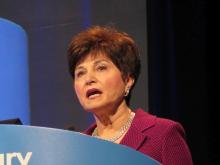SAN FRANCISCO – The androgen receptor inhibitor enzalutamide is efficacious for treating nonmetastatic castration-resistant prostate cancer accompanied by a rapidly rising prostate-specific antigen (PSA) level, according to results of the phase 3 PROSPER trial.
“Nonmetastatic castration-resistant prostate cancer is an area of unmet need with no currently approved therapies. The development of metastases is predictable in this group of patients and is associated with increasing baseline PSA and a PSA doubling time of less than 10 months,” said lead author Maha Hussain, MBChB, deputy director at the Robert H. Lurie Comprehensive Cancer Center of Northwestern University, Chicago. “Delaying time to all metastases, which is a very clinically relevant endpoint because that is the terminal phase of the disease, is important, with the potential to delay cancer-related morbidity and also prolong overall survival.”
The PROSPER investigators enrolled 1,401 men with nonmetastatic castration-resistant prostate cancer and a PSA doubling time of 10 months or less despite castrate levels of testosterone. They were randomized 2:1 to enzalutamide (Xtandi) or placebo, with continuation of androgen deprivation therapy in both groups. (At present, enzalutamide is approved by the Food and Drug Administration for untreated and docetaxel-treated metastatic castration-resistant prostate cancer).
With a median follow-up of 22 months, median metastasis-free survival (based on radiographic progression or death) was about 22 months longer with enzalutamide versus placebo, according to results reported at the 2018 Genitourinary Cancers Symposium sponsored by the American Society of Clinical Oncology, ASTRO, and the Society of Urologic Oncology. The difference translated to a 71% reduction in risk of events.
Relative to peers in the placebo group, patients in the enzalutamide group also had dramatically longer time to PSA progression (93% risk reduction) and time to first use of new antineoplastic therapy (79% risk reduction). An interim analysis showed a trend toward better overall survival with the drug as well, and it was well tolerated.
Although progression on PROSPER was ascertained by conventional imaging, advent of new, more sensitive imaging modalities, such as fluciclovine and prostate-specific membrane antigen PET, are unlikely to change the calculus, according to Dr. Hussain. “These patients have micrometastatic disease. The fact that we have imaging criteria right now that are not very sensitive does not mean we don’t think the patients have micromets. With the newer technologies, certainly, a good chunk of these patients could have physical metastatic disease,” she elaborated. And cancer treatments often achieve greater benefits when moved earlier in the disease course.
Approved indications aside, oncologists will likely take a tailored approach when deciding to treat nonmetastatic castration-resistant prostate cancer with enzalutamide or a similar agent, Dr. Hussain said. “Like anything else, the issue is going to boil down to a shared decision with the patient, pros and cons, and then making a decision together.”
The findings with enzalutamide in the PROSPER trial are also noteworthy in that they largely mirror those obtained with apalutamide in the SPARTAN trial, which were reported in the same session at the symposium.
Weighing the evidence
The 2-year prolongation of metastasis-free survival with apalutamide and enzalutamide is “very impressive,” said invited discussant Philip Kantoff, MD, a medical oncologist and chair of the department of medicine, Memorial Sloan Kettering Cancer Center in New York. “These drugs are very biologically active. This potentially gives us options for men with M0 castration-resistant prostate cancer. It’s something I would like to see as a clinician, but we have to be a little bit cautious. Treating asymptomatic patients carries a certain burden of proof wherein benefit must clearly outweigh risk.”
Clinical benefit of a drug in this patient population could be shown in three ways, he said: curing disease (which is unlikely), prolonging survival (which is as yet unproven), and improving quality of life by, for example, reducing anxiety over rising PSA levels and preventing skeletal-related adverse events (which is hinted at by SPARTAN data showing that enzalutamide delayed time to symptomatic progression).
“Clinical benefit, to me, is not fully demonstrated in these two studies, and there are some untoward effects that need to be better defined,” Dr. Kantoff maintained. In particular, apalutamide was associated with higher (albeit still low) rates of grade 3 or worse falls, fractures, and rash, and enzalutamide with more deaths in the absence of radiographic progression, for unclear reasons.
“My confidence in declaring victory would be greater with further scrutiny of the toxicities and understanding how the care patterns in these studies compare with actual practice, specifically, the timing of initiation of alternative therapies in these trials as opposed to what’s going on in the community,” he said.
It is too early to determine whether one drug is superior, according to Dr. Kantoff. “These were not comparative trials, so we don’t have enough information to say one versus the other. There’s a hint of different toxicity profiles. It isn’t clear that the efficacy is different.” And when it comes to adoption by community oncology, the FDA will have a role, sifting through the data for both drugs and rendering decisions, he said.



